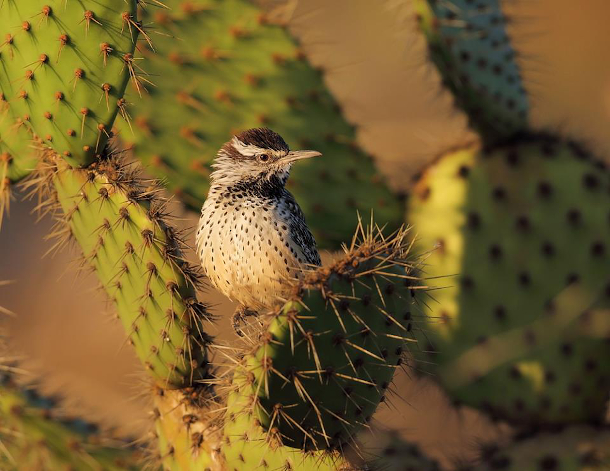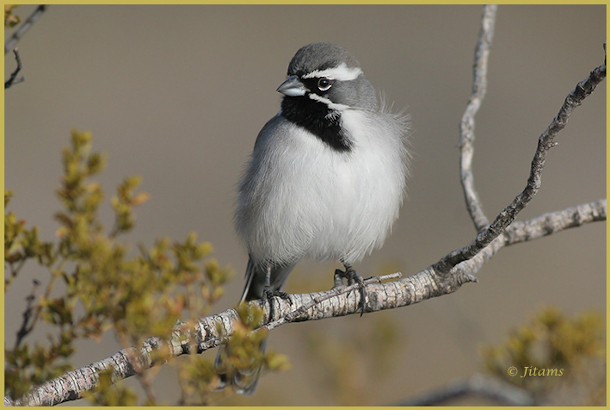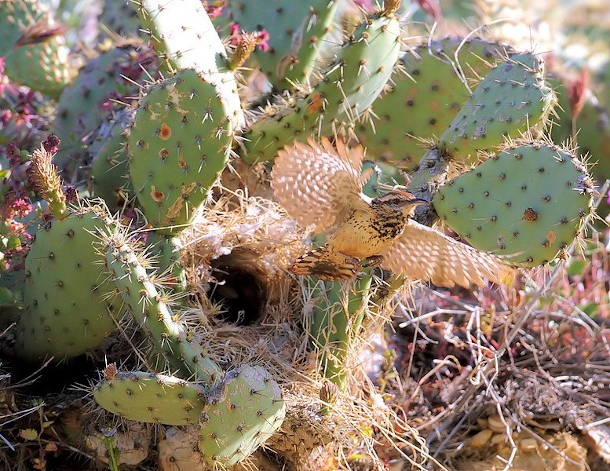BirdNote®: What Do Desert Birds Drink?
Air Date: Week of August 7, 2020

Desert birds like the Cactus Wren make the most of precious little water. (Photo: © Steve Wolfe)
At the height of summer, deserts reach scorching temperatures and water is scarce. But as BirdNote®’s Michael Stein reports, desert birds are well-adapted to the intense heat and dryness.
Transcript
[BIRDNOTE THEME]
CURWOOD: We are in the hot, dog days of summer, here in the northern hemisphere but as BirdNote’s Michael Stein reports for desert birds the searing heat is no problem.
BirdNote®
What Do Desert Birds Drink?
[Desert atmosphere with insect buzz and call of Gambel’s Quail]
In the desert Southwest, summer temperatures sizzle, rising well over 100 degrees. And in some parts of the desert, there is not a drop of water for miles.
Yet some birds thrive in this scorching landscape. Here a Black-throated Sparrow sings from a thorn scrub. [song of Black-throated Sparrow] Now, a Cactus Wren announces itself atop a barrel cactus. [Cactus Wren song] And neither will be flying miles every day to the nearest source of water. So how do they survive?

Black-throated Sparrows extract enough water from seeds that they can go a long time without taking a drink. (Photo: © Joanne Kamo)
Birds, like all animals, perish without water. Desert birds, however, make the most of very little. They tuck into the shade in the heat of the day, so they won’t lose water in panting. They have extremely efficient kidneys, so they excrete almost no liquid. And they obtain moisture from foods, like nectar and fruit as well as insects and other prey. [Insect sounds and Black-throated Sparrow song] Even when eating primarily seeds, Black-throated Sparrows are able to extract enough water from this dry food that they may never need to take a drink.
[Thunder storm sounds]
Still, when that next late summer thunderstorm arrives, you have to think those temporary puddles are going to look mighty refreshing.
[Thunder storm sounds, rain and song of Black-throated Sparrows]

A Cactus Wren takes flight from its nest in a prickly-pear cactus. (Photo: © Steve Wolfe)
Written by Bob Sundstrom
Bird sounds provided by The Macaulay Library of Natural Sounds at the Cornell Lab of Ornithology, Ithaca, New York. Back throated sparrow [50164] and cactus wren [118663] recorded by G. A. Keller.
Desert sounds recorded by Gordon Hempton: dpa desert thunder birds; and Nature Essentials SFX Thunder #7, Rain Aftermath #15, and call of Gambel’s Quail Nature Essentials SFX#136 provided by QuietPlanet.com
BirdNote’s theme music was composed and played by Nancy Rumbel and John Kessler.
Producer: John Kessler
Executive Producer: Chris Peterson
© 2018 Tune In to Nature.org Narrator: Michael Stein
https://www.birdnote.org/show/what-do-desert-birds-drink
CURWOOD: For pictures, fly on over to the Living on Earth website LOE.ORG.
Links
See this story on the BirdNote® website
Living on Earth wants to hear from you!
Living on Earth
62 Calef Highway, Suite 212
Lee, NH 03861
Telephone: 617-287-4121
E-mail: comments@loe.org
Newsletter [Click here]
Donate to Living on Earth!
Living on Earth is an independent media program and relies entirely on contributions from listeners and institutions supporting public service. Please donate now to preserve an independent environmental voice.
NewsletterLiving on Earth offers a weekly delivery of the show's rundown to your mailbox. Sign up for our newsletter today!
 Sailors For The Sea: Be the change you want to sea.
Sailors For The Sea: Be the change you want to sea.
 The Grantham Foundation for the Protection of the Environment: Committed to protecting and improving the health of the global environment.
The Grantham Foundation for the Protection of the Environment: Committed to protecting and improving the health of the global environment.
 Contribute to Living on Earth and receive, as our gift to you, an archival print of one of Mark Seth Lender's extraordinary wildlife photographs. Follow the link to see Mark's current collection of photographs.
Contribute to Living on Earth and receive, as our gift to you, an archival print of one of Mark Seth Lender's extraordinary wildlife photographs. Follow the link to see Mark's current collection of photographs.
 Buy a signed copy of Mark Seth Lender's book Smeagull the Seagull & support Living on Earth
Buy a signed copy of Mark Seth Lender's book Smeagull the Seagull & support Living on Earth

